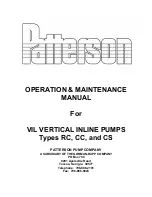
4
819.0254
TOXIC FLUID HAZARD
Hazardous fluid or toxic fumes can cause serious injury or death if splashed in the eyes or on the skin,
inhaled, or swallowed.
•
Know the specific hazards of the fluid you are using.
•
Store hazardous fluid in an approved container. Dispose of hazardous fluid according to all local,
state and national guidelines.
•
Always wear protective eyewear, gloves, clothing and respirator as recommended by the fluid
and solvent manufacturer.
•
Pipe and dispose of the exhaust air safely, away from people, animals, and food handling areas.
If the diaphragm fails, the fluid is exhausted along with the air. See Air Exhaust Ventilation on
page 9.
•
Never use an acetal pump to pump acids. Take precautions to avoid acid or acid fumes from
contacting the pump housing exterior. Stainless steel parts will be damaged by exposure to acid
spills and fumes.
FIRE AND EXPLOSION HAZARD
Improper grounding, poor ventilation, open flames, or sparks can cause a hazardous condition and
result in a fire or explosion and serious injury.
•
Ground the equipment. Refer to Grounding on page 5.
•
If there is any static sparking or you feel an electric shock while using this equipment, stop
pumping immediately. Do not use the equipment until you identify and correct the problem.
•
Provide fresh air ventilation to avoid the buildup of flammable fumes from solvents or the fluid
being pumped.
•
Pipe and dispose of the exhaust air safely, away from all sources of ignition. If the diaphragm
fails, the fluid is exhausted along with the air. See Air Exhaust Ventilation on page 9.
•
Keep the work area free of debris, including solvent, rags, and gasoline.
•
Electrically disconnect all equipment in the work area.
•
Extinguish all open flames or pilot lights in the work area.
•
Do not smoke in the work area.
•
Do not turn on or off any light switch in the work area while operating or if fumes are present.
•
Do not operate a gasoline engine in the work area.
•
Keep a fire extinguisher in the work area.
WARNING





































